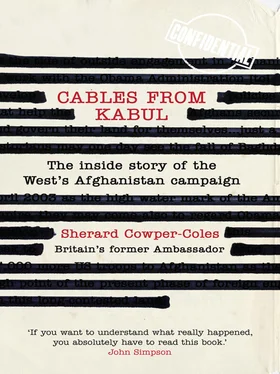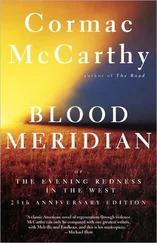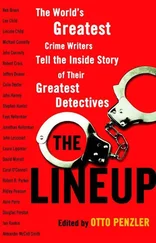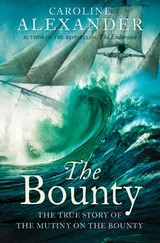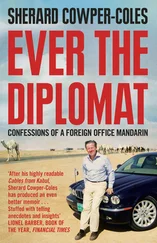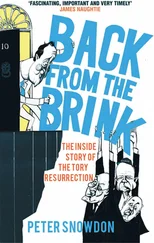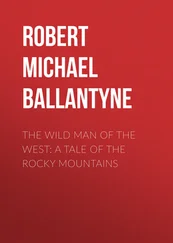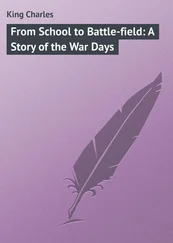Thus it was that on a May evening in 2007 I found myself climbing self-consciously into a large black Jaguar outside my home in Balham to begin the long journey to Kabul. As the chauffeur in an oddly anachronistic peaked cap negotiated the late rush-hour traffic, I reflected that the challenges in Kabul would be much greater, and much more real for Britain, than those I had faced in my two previous Embassies, Tel Aviv and Riyadh, each tough in its own way. How right that was to prove. I confess that I also wondered how, or whether, I would survive – literally. My posting had resulted in a huge leap in my life insurance premium, to which the Foreign Office was properly contributing.
An easy overnight ride to Dubai on Emirates, whose aircraft I would come to know so well over the next three years, brought my first surprise. Flights onward from Dubai to Kabul left not from the main terminal, but from one across the airfield, with decidedly inferior facilities. From here – dubbed the ‘Axis of Evil’ Terminal – the departures board announced flights to Baghdad, Tehran, Harare and a host of other exotic destinations.
And it was here that I first came across the civilian flotsam of the international conflict industry: Men In Beards, mostly, exotically tattooed, wearing sand-coloured cargo pants, military backpacks hoisted over their shoulders. Most looked like, and probably were, former soldiers, now making money as private security guards. Others were aid workers, journalists, spies or Special Forces types in thin disguise, or, just occasionally, diplomats trying to look more macho than they really were. Scattered along the line of male mercenaries checking in for the UN flight to Kabul were only a few women, of the confidently eccentric beauty which danger zones seem to attract.
The flight was terrifying. Service, from the South African crew of the ancient UN charter plane, was elementary. Apart from my fellow passengers, the landscape – the Straits of Hormuz, the mountains of southern Iran, then the dusty plains of Pakistani Baluchistan, followed by the great southern deserts of Afghanistan, divided by the grey-green valleys of the Helmand River and its tributaries – was the only entertainment. We moved north and east, and mountain ridges and then ranges rose out of the desert. As the ancient plane climbed laboriously up and over them towards Kabul, we ran into a series of violent summer storms. Circling around the great basin in the mountains in which the Afghan capital lies, we pitched and yawed for at least an hour, before the pilot told his relieved passengers that we would wait in Islamabad for the dust to settle, literally.
Three hours later than planned, we touched down in Kabul. From the window I could see a curious cocktail of aircraft. Ancient Antonovs and Ilyushins, and recently refurbished Mil helicopters, seemed to symbolise Afghanistan’s past and perhaps its future. But the foreground – the present – was filled with Western military airframes: everywhere the C-130 Hercules, the utility truck of modern expeditionary warfare, bearing US, British, Canadian, Dutch, Danish and even Australian markings. Swarms of helicopters – American Black Hawks and Chinooks, a brace of French Eurocopters – covered the apron, plus a motley collection of civil aeroplanes: small propeller-driven aircraft in UN white; larger and older Boeings on charter, disgorging troops; and a rag-bag assortment of airliners of varying vintages, painted in the colours of airlines I had never heard of: Ariana, Kam Air, Pamir, Safi, among others.
My Deputy, Michael Ryder, an old Foreign Office friend and colleague, with the quizzical air of the Cambridge historian he once was, greeted me at the foot of the steps, along with my Royal Military Police Close Protection Team. I was hustled into a heavily armoured Land Cruiser and quickly briefed by the Team Leader: ‘Never open the door yourself. If there’s an incident, Sir, get down, and do exactly as we say. If we are incapacitated, this is the radio, and this our call sign. We are all medically trained, and there is a full first-aid kit in the back.’
We took the long, and supposedly safer, route to the Embassy. Only later did I learn that the direct route – Route White – was known as suicide alley. We wended our way through Kabul’s north-western suburbs. I saw for the first time just how poor the place was, how squalid the conditions were in which most of the population somehow survived, how far the city had been wrecked, mostly in the savage intra-Afghan fighting which had followed the collapse of the Najibullah regime in 1992. That had been before the Taliban had ridden into town and restored order in 1996.
In my three years living in or visiting Afghanistan I would never tire of the rich panorama of Kabul street life: donkey carts, flocks of sheep and goats, bazaars for everything from printer cartridges to garden hoses, and low-tech engineering of the most creative kind, producing anything from axes to air compressors. Scattered around were the wrecked remnants of what had once been the garden city of South-west Asia, a city of tree-lined avenues and lush parks, to which the citizens of neighbouring countries had repaired for the 1960s equivalent of a mini-break. Now it was all laid waste. There was virtually nothing to show for five and a half years of Western engagement, apart from the narco-tecture of the drug lords’ palaces on stolen land, and an encroaching tide of checkpoints, sandbags and earth-filled barriers of hessian and wire mesh. For me, the most poignant symbol of Kabul’s desolation will always be the catenary poles for the Czech-made trolleybuses which once crisscrossed the city, now standing splayed against the sky, their torn wires flapping in the wind.
And then we reached the Residence. Smartly saluting Gurkha guards swung open two black metal gates in a nondescript side-street. We were in the garden of a neat suburban villa, an Afghan version of a Barratt home, with a narrow lawn, a small swimming pool, a terrace, three guest bedrooms, a one-bedroom flat for me, with an armoured keep – in fact my bathroom – in which I could (and would) take refuge, all hurriedly furnished by the Foreign Office estates team in a much mocked blend of IKEA and the Land of Leather. The only clues that this was the British Ambassador’s Residence were the Royal Coat of Arms affixed, with a brass plate, to the wall by the front door; an idiosyncratic selection of gloomy British landscape paintings which my predecessor had persuaded the Government Art Collection in London to send out; and, hidden on the shelves of a pine-veneer sideboard, a small collection of battered silver rescued from Britain’s grand old Embassy in Kabul.
In 1920, when the Foreign Secretary Lord Curzon ordered the construction of what was then known as the British Legation in Kabul, he decreed that the British Minister in Kabul should be the best-housed man in Asia. Ninety years later, Her Britannic Majesty’s Representative in Kabul was not exactly the best-housed man in Kabul, let alone in Afghanistan, still less in Asia. Nevertheless, the Residence was warm in winter and cool in summer. A loyal and conscientious team of Afghans made it all work. The ability to offer British, international and Afghan guests food, drink and even a bed at almost any hour, with little or no notice, proved to be a powerful tool for the job – the kind of ‘corporate entertainment facility’ which every good ambassador’s residence should be.
On that May evening, Michael Ryder had assembled well over a hundred members of the Embassy staff for a barbecue to meet the new Ambassador. It was only then, as I moved from group to group gathered in the dusk, that I realised just how diverse my new team would be. At least a third were women. There were people of many different ethnic backgrounds, and with disabilities (courageously, in Kabul).
Читать дальше
